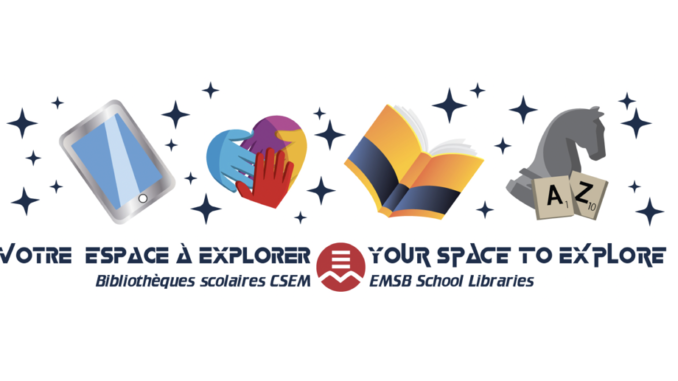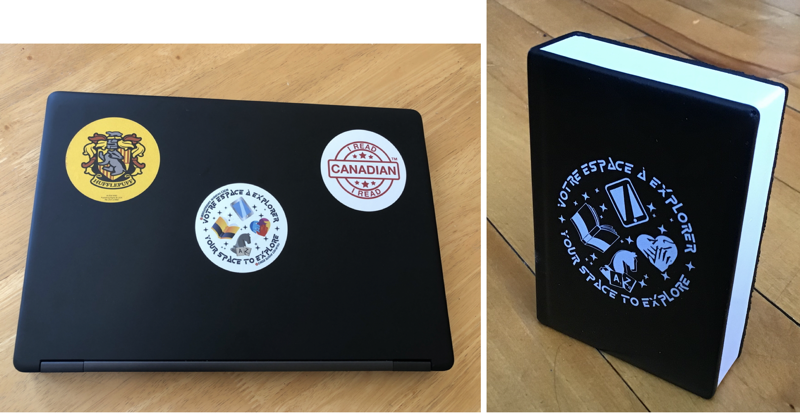
By Julian Taylor
With all the anxiety, fear, and uncertainty of the current pandemic situation, it is hard to believe that this is also the same school year that saw fun, excitement, and optimism. While our schools and their libraries here in Montreal are closed until the fall (along with most of Canada), we can’t forget the great things each of us did across Canada this school year to help move our libraries forward and find better ways to help serve our students and teaching staff. Here at the English Montreal School Board, we had a wondrously good start to the school year that carried over for many months and will have positive impacts into next school year. This is the story of what happened and how.
The year started off as per normal, with lots of planning and figuring out which of our ideas from the previous school year would be able to actually work out this year, when we three board-level librarians (Danielle Juneau, Alissa Rosellini, and myself) were approached by the head of the Communications Department for the board. He said that this was the year that we were going to single out the “new library learning commons” we had in many of our schools and highlight it in the news media. As you can expect, we were all a little stunned. Needless to say much of our planning for projects for the year was quickly shelved.
Marketing the school board using its libraries
Each year, the school board’s Communications Department chooses one aspect of our schools and uses it to publicize the great things going on at the English Montreal School Board in the aim of encouraging parents to send their children to our schools instead of to one of the French language school boards or private schools that share our territory. Under Quebec law, only children of parents who attended English schools in Canada are eligible to attend English public schools; everyone else has to attend a French public school, despite the fact the majority of our “English” elementary schools are actually bilingual or French immersion. With birth rates in Quebec, like the rest of Canada, being lower than the replacement rate, the enrollment in English public schools is shrinking quickly. This leads to a big marketing push to convince eligible parents to enroll their children in our schools.
As in previous years, they were going to be focusing on a single theme to promote, like robotics and coding in schools, or on physical literacy. A big media event took place each January at one of our elementary schools, there were interviews with reporters, invited guests to meet with kids, activities for the students and guests, and of course it was all in front of reporters who would run stories about the day on their noon-hour and evening television news broadcasts. Then there would be articles and podcasts over the rest of the school year to carry the message further and the next year’s school calendar would have images related to the chosen theme. It was an involved multi-month plan.
So, when we were told that the theme to be announced in January 2020 was to be “the new library learning commons”, we were thrilled as this was a fantastic opportunity to promote what our libraries can offer to our students. This was in fact the biggest ever opportunity for promoting our school libraries that we had ever had. However, we were also a bit confused… how could we publicize the “new” thing that we have been developing in bits and pieces for over a decade, something that was “always in beta” (as Carol Koechlin would say)? If something is not “done”, how can you publicise it as a finished package? This led to many conversations before we (the three board-level librarians, our assistant director, and the communications team) finally came up with a unified message: we were going to celebrate all the steps forward that we (as a school board community) had accomplished over the years; that there was more to come and that we wanted to encourage additional schools to focus more on what their libraries could do in cooperation with their schools. Hopefully this would also push forward the understanding that a library learning commons is more than a traditional library with a cosmetic face-lift.
This led to a series of meetings over a couple of months to decide everything. There were many many questions to be answered: Which elementary school would be the best one to showcase? Who would be invited as special guests? What would the guests be expected to do? Who gets invited from the other schools?
The choice of school was thankfully not too difficult; one of our East End elementary schools, Nesbitt Elementary, which is over a century old now. It has a massive physical space for the library, along with a principal who is very pro-library learning commons. We board-level librarians had worked alongside the changing administration and library staff in that school for many years and so we all had a good working relationship. The library has several segmented areas that are ideal for groups of students to work together collaboratively, a reasonable level of technology to showcase that aspect (including a wall mounted smart TV and iPad stations, a full computer lab accessible directly from the library), and good natural lighting. In short, it worked well to demonstrate many of the physical aspects that we hoped to see in a library learning commons.
How to promote the library learning common concept?
Perhaps the hardest questions for our combined library and Communications team revolved around the slogan (which had to work in both English and French) as well as what images do we use to promote something as complicated and abstract as the library learning commons model?
The slogan proved to be the less difficult part; “Your Space to Explore” / “Votre espace à explorer”. We wanted to place the emphasis on it being the library users’ area and that they were in charge of their exploration, discovery, and learning. The traditional pictograph for the library is the silhouette of a person reading a book, but that hasn’t really worked for a long time. After much back and forth and complete redesigning, we decided that there could not be a single image for school libraries. Instead, we decided to incorporate a series of images: game playing pieces (including the “A” and “Z” tiles from Scrabble to imply that the library has everything you need from A to Z, and of course the idea of learning through play), a tablet to draw attention to the digital component, a paper book to show that we have not given up on our traditional values, and a heart made up of many different coloured hands overlapping to signify collaboration, acceptance and the emotional connection of the people (students and staff) who call the library theirs.

Once that was figured out, Communications was able to purchase some fun logo-branded gifts to hand out to the students and guests. including tote bags, small notebooks, black-coloured stress relief squeezable foam books and laptop stickers.

Who Would Come and What Would They Do?
The big event launch day would be led by two reporters acting as the masters of ceremonies; one from CTV Montreal and the other from Global TV. Speeches would be given by students, directors, us librarians, the Director General of the school board, etc… But then what do we do? The students needed to be involved in some way to make it meaningful to them. The first obvious activity was to have our guests reading their favourite children’s stories to the students in their classrooms, which everyone always loves. However, if we were talking about the “new” direction for libraries, we had to go further than that. The one idea that sparked everyone’s interest was the idea of having the guests also participate in a human library. One of our high schools had already successfully run a human library project for two years in a row and it is something that we were trying to promote in other schools as a way to help broaden the minds of our students and help develop empathy. Our guests, who came from a wide variety of backgrounds, would be excellent “human books” that the students could learn from. At the same time it would serve as a real life example to members of the visiting schools as to how a human library could work in their schools too.
In the end, some of our guest speakers included noted children’s author Elise Gravel, Woody Baron (a player from the Montreal Alouettes who had also co-written a children’s book), the local MNA (Quebec equivalent of MPP or MLA), other Quebec authors, as well as a few local reporters who were doing double-duty as reporters and taking part in the human library for the students.
Getting Ready for “The Big Day”
A mini-website was created, a sub-site of the main school board, that served as a main information portal for parents and other community members who wanted to learn more about the changing libraries and their important role in the education of our children. Danielle, Alissa, and I met with a writer from the Communications Department several times to try to get the information as accurate as possible. You can see that site at: schoollibrariesmtl.ca
In the week leading up to the event, Alissa and I were interviewed over the phone by a reporter from the Montreal Gazette, who was tasked with trying to explain to people who do not work in education exactly what a library learning commons was, how it was different from what most parents experienced when they were children and why this was something to be desired in a modern school library. The article was scheduled to be published the same day as the event at Nesbitt. You can read that article here.
Everything was set. Thankfully, the Communications Department was well practiced in these annual events and very little was left to chance.
Now we just had to wait and hope that we didn’t have a massive winter storm with 30 cm of snow that blocked traffic and closed the schools… it was Montreal in January so this was a very real concern.
“The Big Day” Finally Arrives
The weather cooperated. There were no unexpected crises. Everyone showed up on time. The local weather report was broadcast live from the school’s library. It was almost unbelievable. Everything worked out and the students were happy. There were literally hundreds of extra people at the school that day. It seemed like there were reporters and authors every which way you turned. You can see the energy and excitement in some of the news report videos below.
Alissa, as planned, was able to take part in the CBC Radio Noon Montreal broadcast where she explained why we were doing all this and why it was important to make sure students had access to these powerful library resources. CBC Radio recording: You can hear her section of the interview starting at 17 mins and 20 seconds.
Extensive Media Coverage
GLOBAL TV
EMSB re-imagined libraries
Global News at 5:30 Montreal: Jan 24
CITY NEWS
Human library at Nesbitt
EMSB Transforming Its Libraries
Als Woody Baron reads to students: Stu Cowan: Als lineman/author Woody Baron shows kids school is cool
Epilogue
How this plays out long term is anyone’s guess. Did this influence other schools to further embrace the library learning commons model? Based upon feedback and requests from different schools, we think so. Did it help convince more parents to enroll their children in our schools? We have no idea, but I’d like to think it may have. One thing is for sure, it was a big step forward for school library advocacy at the EMSB and all of the other nearby school boards.
The current pandemic may have thrown a monkey wrench into the plans for follow up publicity. However, living in a new reality where online distance education is now the temporary(?) norm, we’ve been able to show once again how school librarians can make a difference. Whether it be helping Educational Consultants by validating and curating digital resources that they share with teachers and parents, collaborating with other Educational Consultants to help with digital citizenship initiatives for students and their parents, working to determine the copyright issues around sharing different online resources, working to increase the holdings of our Virtual Library to help our students learning at home, or to track down titles that teachers want to use in their activities, it has certainly been a year to mark as full of powerful examples of what school librarians can do as a part of the education team.

Julian Taylor, having previously worked in both elementary and secondary school libraries, is currently a board-level librarian in the Educational Services Department of the English Montreal School Board. He works to assist other library personnel, as well as administrators, educational consultants and teachers to help improve school library services and digital citizenship skills for everyone.
He also spent 6 years at the Quebec Ministry of Education working on Information Literacy, Digital Citizenship, as well as being the liaison between the Ministry and school libraries in the English sector of Quebec. For the last seven years he has also been the chair of QSLiN (the Quebec School Librarians Network), where he helps to coordinate school library initiatives across the English sector of Quebec. In addition to these activities, he was also the President of the ABQLA (L’Association des bibliothécaires du Québec-Quebec Library Association) in 2017-2018.
He is occasionally active on Twitter @JulianMTaylor
MLIS McGill 2000